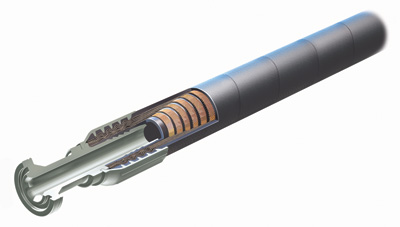Crimped-on fittings are permanent. This requires a bit of machinery. You may have seen reusable hose ends, where one end will go on the hose itself. The other end simply gets inserted into the hose.
 The special machinery required if you are doing a permanent crimped hose, can be a a hand pump style crimping machine. You have a set of dies, and there’s a tray there below that you open up, and it’s got all your dies that are all in there. You change the dies in the machine based on the diameter of the hose that you’re going to be crimping. Each set of dies will do a range of hose. You might have one set of dies that can do between three-eighths and half inch hose. Then you insert a larger set of dies to do your five-eighths, three-quarter.
The special machinery required if you are doing a permanent crimped hose, can be a a hand pump style crimping machine. You have a set of dies, and there’s a tray there below that you open up, and it’s got all your dies that are all in there. You change the dies in the machine based on the diameter of the hose that you’re going to be crimping. Each set of dies will do a range of hose. You might have one set of dies that can do between three-eighths and half inch hose. Then you insert a larger set of dies to do your five-eighths, three-quarter.
There’s a dial in front of this as well. Based on the specifications given to you by the hose manufacturer and the fitting manufacturer, it’ll set a particular diameter that … That dial is a micrometer that allows you to set that distance so that it’ll automatically stop crimping at the desired diameter. As far as the crimper goes, this is pretty inexpensive and it’s pretty affordable as well. You see these things in the back of a service truck.
Any average hose shop will have something more like this. This may have a hydraulic valve and is hydraulically powered. It plugs in to the wall. It’s electrical. It’s accurate. It’s got the full complement of dies in it. There’s even a chart on the front of it to help you with your micrometer and all your settings to make it quick and easy. If you’re a very high volume shop, you have something like this, the CMC crimper.
Once you have your crimper, you’ll take this machine, and then look into the data given to you by your hose and fitting manufacturer. Flip into the general catalog, you’ll see they give you that cut off factor. That’s that CA. Every fitting is going to have different cut off factor, so when you’re measuring your hose end-to-end, you’ll then subtract the cut off factor, and those two cut off factors are subtracted from your whole hose length or the length that you cut your hose at.
You set that up. You set your dies. You set that number. Cut your hose. Put the fitting on. Crimp it. After you crimp it, that crimp diameter, you see the crimp with the zero, with the circle through it, that’s your finished crimp diameter. For example, you can be doing the T3010A, the third from the bottom hose, you want that final crimp diameter be 1.035 inches. That’s a pretty accurate number, and that’s pretty specific.
How do you get that? You get it with a set of calipers. You can get these at any kind of tool store or any one of your machine suppliers. That will give you down to a thousandth of an inch. In this case, this one gives half a thou. We use this to measure hose, to make sure it is … There’s a range you could get within a few thou either side. Some ranges could be bigger. It doesn’t have to be bang on every time. It’ll let you know either your machine is out of calibration or you inserted the wrong dies or even you set it to the wrong setting. Just make sure that every hose is crimped right the first time and that things are not going to pop off on you.

Leave a Reply